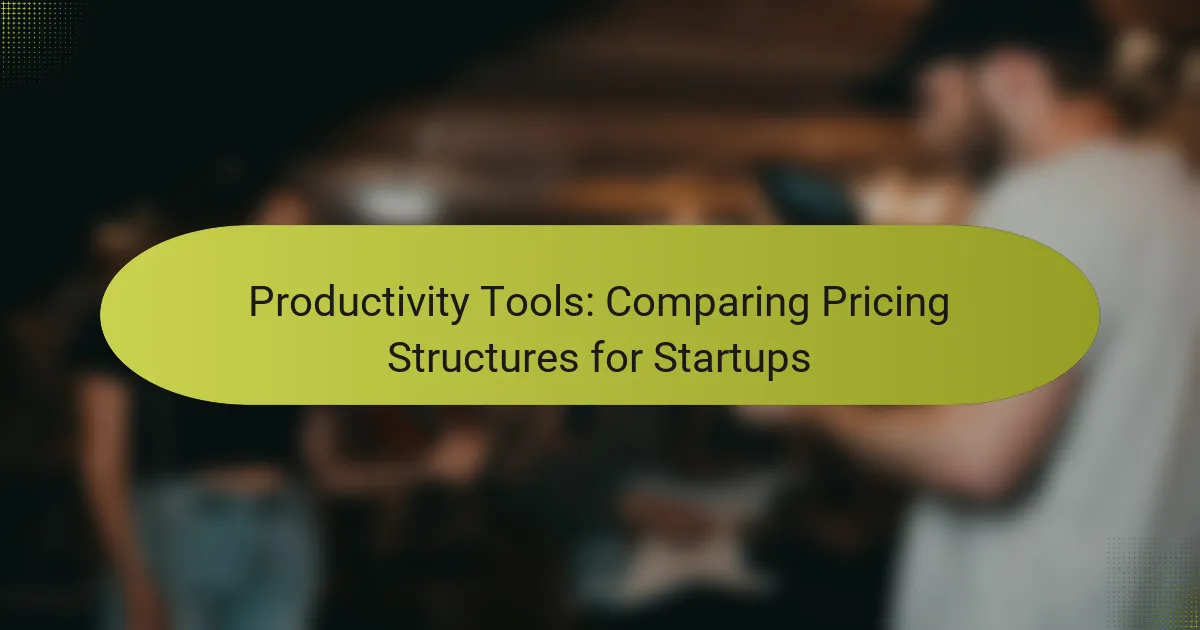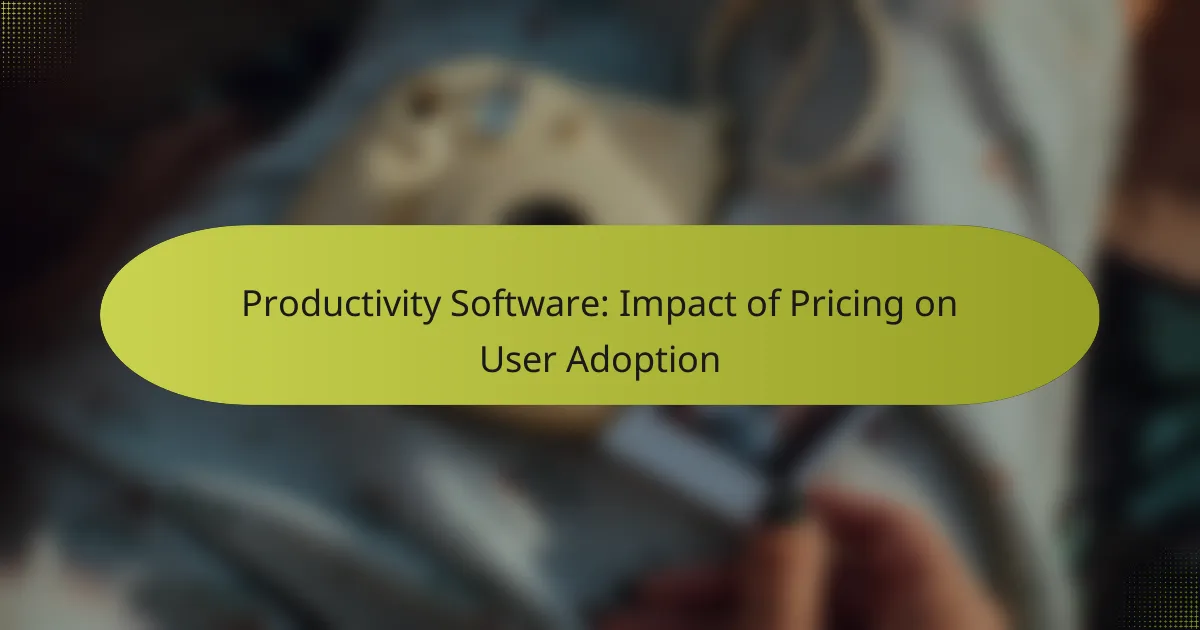Tiered pricing models are an effective strategy for SaaS products, enabling companies to offer flexible pricing options that match customer usage levels. By catering to diverse user needs and budgets, businesses can optimize revenue while providing cost savings for customers who may not need full features. This approach not only attracts a wider range of customers but also ensures that companies can capture various market segments effectively.

How can tiered pricing models save money for SaaS products in the UK?
Tiered pricing models can save money for SaaS products in the UK by offering customers flexible pricing options that align with their usage levels. This approach allows businesses to cater to a variety of user needs while optimizing revenue and reducing costs for customers who may not require full features.
Flexible payment options
Tiered pricing provides multiple payment levels, enabling customers to select a plan that best fits their budget and usage requirements. For instance, a SaaS product might offer basic, standard, and premium tiers, allowing users to upgrade or downgrade based on their changing needs. This flexibility can lead to significant savings, especially for startups or small businesses with limited budgets.
By allowing customers to pay only for the features they use, companies can attract a broader audience. This model also reduces the risk of customer churn, as users feel they have control over their spending.
Cost-effective for varying user needs
Different users have different needs, and tiered pricing accommodates this diversity effectively. For example, a small team may only need essential features, while larger organizations might require advanced functionalities. By structuring pricing tiers accordingly, SaaS providers can ensure that customers are not overpaying for unnecessary features.
This model can lead to a more satisfied customer base, as users can choose a plan that aligns with their specific requirements. It also encourages businesses to continually improve their offerings to justify higher tiers, enhancing overall value.
Encourages customer retention
Tiered pricing models can significantly enhance customer retention by allowing users to easily adjust their plans as their needs evolve. When customers feel they are getting value for their money, they are more likely to remain loyal to the service. For instance, a user who starts with a basic plan may upgrade to a higher tier as their business grows, rather than switching to a competitor.
Additionally, offering incentives such as discounts for long-term commitments at higher tiers can further encourage users to stay. This not only stabilizes revenue for the SaaS provider but also fosters a sense of partnership with the customer, enhancing long-term relationships.
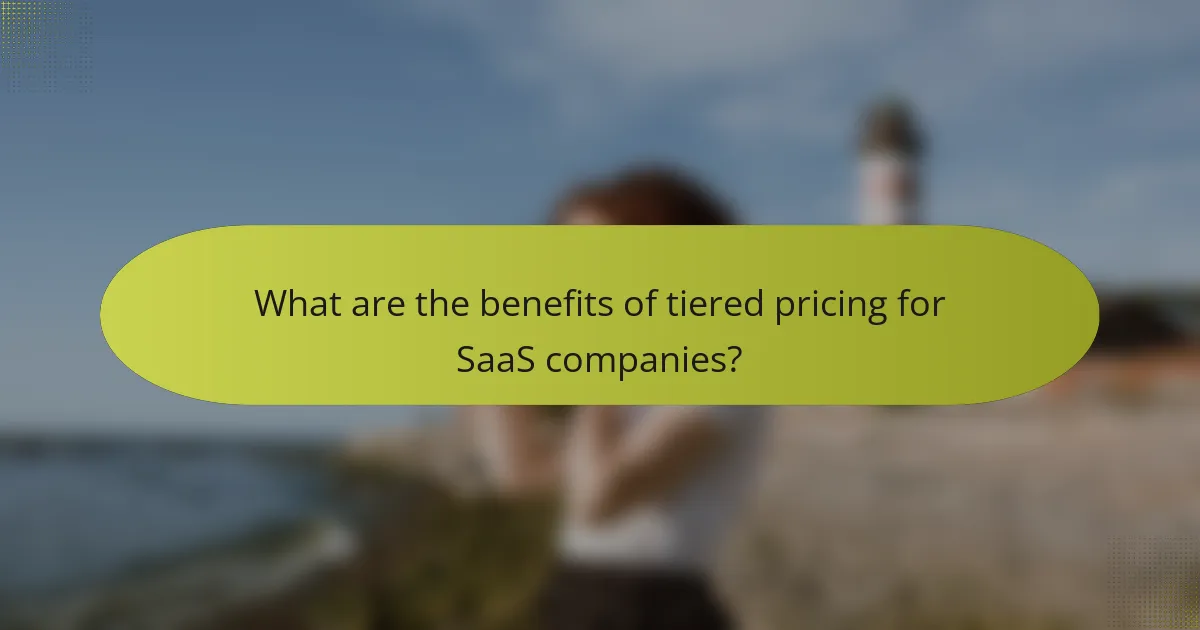
What are the benefits of tiered pricing for SaaS companies?
Tiered pricing offers SaaS companies a flexible pricing strategy that can attract a wider range of customers while maximizing revenue. By providing multiple pricing levels, businesses can cater to different user needs and budgets, ensuring that they capture more market segments.
Increased revenue potential
Tiered pricing models can significantly boost revenue by allowing customers to choose plans that best fit their usage and budget. For instance, a basic plan might attract price-sensitive users, while premium tiers can appeal to those needing advanced features. This structure encourages upselling as customers grow and require more capabilities.
Additionally, offering a range of pricing options can lead to higher average revenue per user (ARPU). Companies often see an increase in overall sales when they provide clear value at each tier, making it easier for customers to justify their spending.
Better market segmentation
With tiered pricing, SaaS companies can effectively segment their market by targeting different customer demographics and usage patterns. Each tier can be designed to meet specific needs, such as small businesses, mid-sized companies, or enterprise clients, allowing for tailored marketing strategies.
This segmentation not only helps in attracting diverse customer bases but also aids in understanding customer preferences. By analyzing which tiers are most popular, companies can refine their offerings and enhance their marketing efforts to better align with customer expectations.
Enhanced customer satisfaction
Customers appreciate having options that align with their specific requirements, leading to higher satisfaction levels. Tiered pricing allows users to select a plan that fits their needs without paying for unnecessary features, fostering a sense of value and control.
Moreover, as customers’ needs evolve, they can easily upgrade to higher tiers, ensuring they always have access to the right tools. This flexibility not only retains customers but also builds loyalty, as users feel their changing needs are being met effectively.
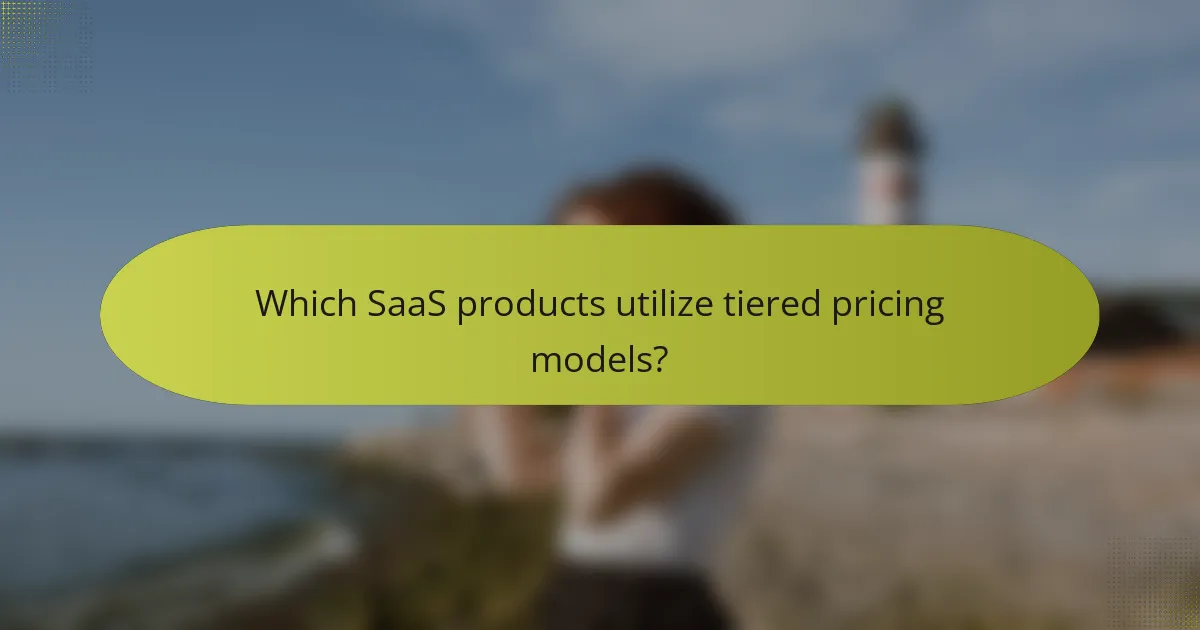
Which SaaS products utilize tiered pricing models?
Many SaaS products leverage tiered pricing models to cater to different customer needs and budgets. This approach allows users to select a plan that aligns with their usage requirements, often resulting in cost savings for both small and large businesses.
Salesforce
Salesforce offers a tiered pricing structure that includes several plans, each designed for different business sizes and needs. The basic plan provides essential CRM features, while higher tiers unlock advanced functionalities like automation and analytics.
Businesses should consider their specific requirements when choosing a plan. For example, small teams may find the lower-tier options sufficient, while larger organizations might benefit from the comprehensive features available in the premium tiers. Pricing typically starts in the low hundreds of USD per month.
HubSpot
HubSpot’s tiered pricing model is structured around its marketing, sales, and service hubs, allowing users to select a plan based on their operational needs. Each tier provides progressively more features, such as advanced reporting and integrations with other tools.
When evaluating HubSpot, businesses should assess their growth stage and marketing strategies. The free tier offers basic tools, while paid plans can range from a few hundred to several thousand USD per month, depending on the features selected.
Zoom
Zoom employs a tiered pricing model that caters to various user needs, from individual users to large enterprises. The free plan allows for basic meetings, while paid tiers offer features like extended meeting durations and additional administrative controls.
Organizations should analyze their meeting requirements and participant numbers when selecting a plan. For instance, small teams may find the Pro plan adequate, while larger companies might require the Business or Enterprise tiers, which can range from around 15 to several hundred USD per month.

How to choose the right tiered pricing model for your SaaS?
Choosing the right tiered pricing model for your SaaS involves understanding your audience, analyzing competitors, and evaluating your service features against costs. A well-structured tiered pricing model can enhance customer satisfaction while maximizing revenue.
Understand your target audience
Identifying your target audience is crucial for developing a tiered pricing model that resonates with potential customers. Consider their needs, budget constraints, and willingness to pay for various features. Surveys and user feedback can provide valuable insights into what your customers value most.
Segment your audience based on factors such as company size, industry, and usage patterns. This allows you to tailor your tiers to meet the specific demands of different groups, ensuring that each tier offers appropriate value.
Analyze competitor pricing strategies
Examining competitor pricing strategies helps you position your SaaS product effectively in the market. Look at how similar services are priced and the features they offer at each tier. This analysis can reveal gaps in the market that your product can fill.
Consider creating a comparison table that outlines competitor tiers, pricing, and features. This visual aid can help you identify competitive advantages and inform your pricing decisions. Aim to offer unique features or better value to differentiate your tiers from those of competitors.
Evaluate service features and costs
Assessing your service features and associated costs is essential for setting a sustainable pricing model. Determine which features are core to your service and which can be offered as premium options. This distinction will help you create tiers that appeal to different customer segments.
Calculate the costs of providing each feature, including development, support, and maintenance. Ensure that your pricing covers these costs while remaining attractive to customers. A common approach is to offer basic features at lower tiers and advanced functionalities at higher tiers, encouraging upgrades as users grow.

What are common pitfalls in tiered pricing models?
Common pitfalls in tiered pricing models include overcomplicating the tiers, neglecting customer feedback, and ignoring market trends. These issues can lead to confusion, customer dissatisfaction, and ultimately lost revenue.
Overcomplicating pricing tiers
Overcomplicating pricing tiers can confuse potential customers and deter them from making a purchase. When too many options are presented, customers may struggle to understand which tier best fits their needs. Aim for a clear structure with a limited number of tiers, typically three to five, to simplify decision-making.
Consider using descriptive names for each tier that reflect the value offered, rather than just numerical labels. For example, instead of “Tier 1,” “Tier 2,” and “Tier 3,” use names like “Basic,” “Pro,” and “Enterprise” to convey the differences clearly.
Neglecting customer feedback
Neglecting customer feedback can result in a tiered pricing model that does not align with market demands. Regularly solicit input from current and potential customers to understand their needs and preferences regarding pricing. This feedback can guide adjustments to your tiers to better meet customer expectations.
Implementing surveys or focus groups can provide valuable insights. Additionally, monitoring customer behavior and usage patterns can highlight which features are most valued, allowing for more effective tier structuring.
Ignoring market trends
Ignoring market trends can leave your pricing model outdated and less competitive. Stay informed about industry standards and competitor pricing strategies to ensure your tiers remain attractive. Regularly review market research reports and competitor offerings to identify shifts in pricing practices.
Consider adjusting your tiers based on emerging trends, such as the increasing demand for subscription flexibility or the popularity of pay-as-you-go models. Adapting to these trends can enhance customer satisfaction and retention.
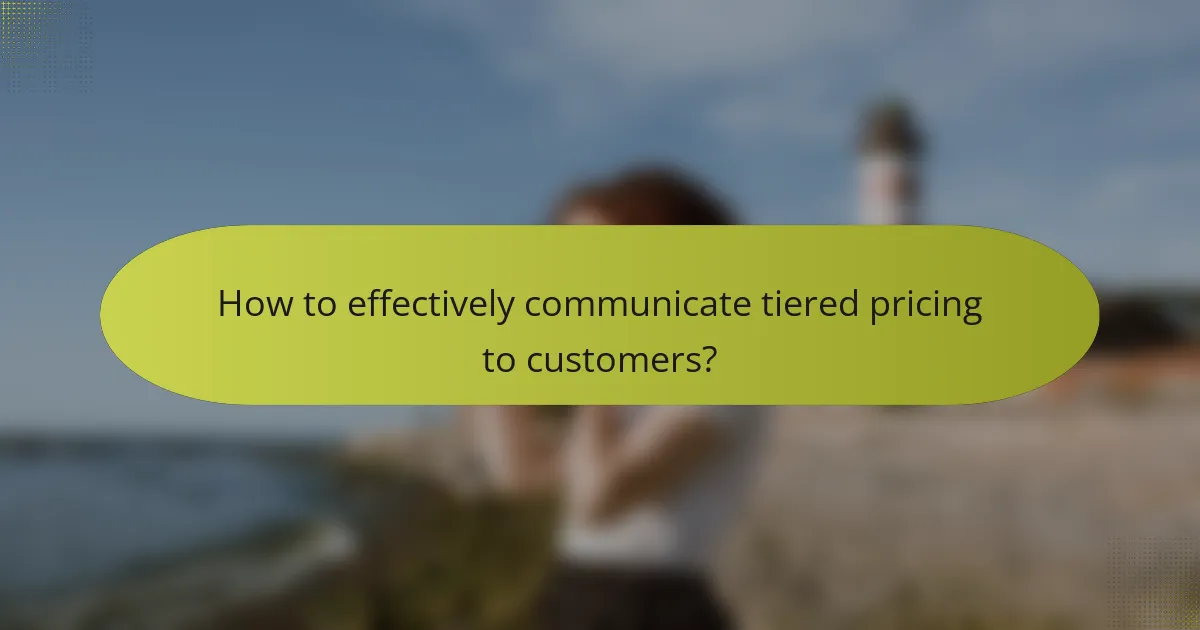
How to effectively communicate tiered pricing to customers?
Effectively communicating tiered pricing to customers involves presenting clear options that highlight the value at each level. Use straightforward language and visual aids to ensure customers understand the benefits and differences between tiers.
Clear pricing tables
Clear pricing tables are essential for conveying tiered pricing. They should list each tier side by side, showing the price and key features in a concise format. This allows customers to quickly compare what they will get at each level.
For example, a SaaS product might have three tiers: Basic at $10/month, Pro at $30/month, and Enterprise at $100/month. Each tier’s table entry should clearly outline the features included, such as user limits, storage capacity, and support options.
Transparent feature comparisons
Transparent feature comparisons help customers understand what they gain by choosing a higher tier. Use bullet points or checkmarks to indicate which features are included in each tier, making it easy to see the added value.
For instance, if the Basic tier offers email support while the Pro tier includes live chat and priority support, clearly highlight these differences. This transparency encourages customers to consider the benefits of upgrading.

